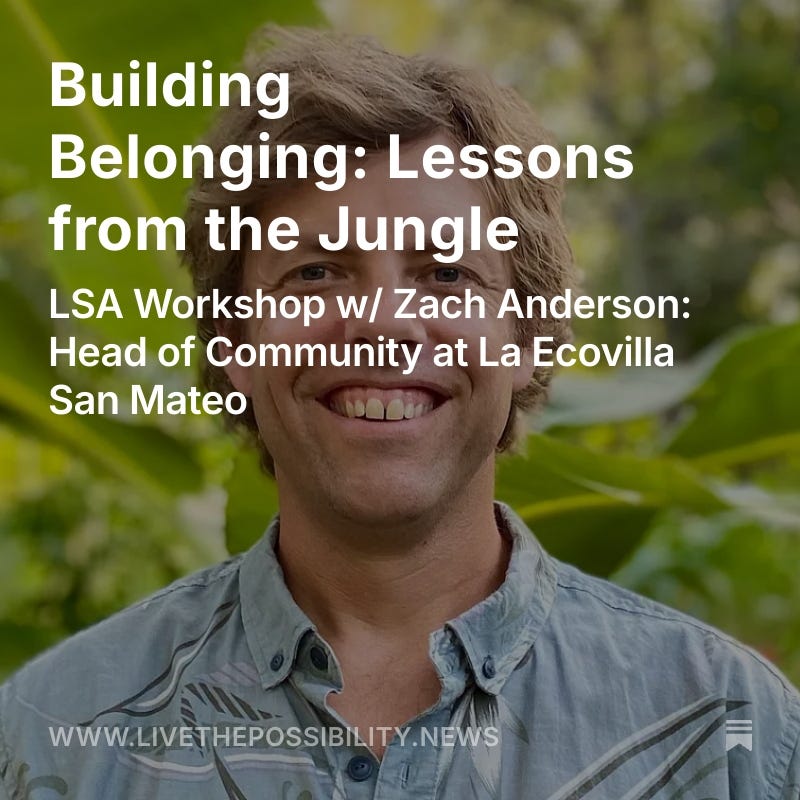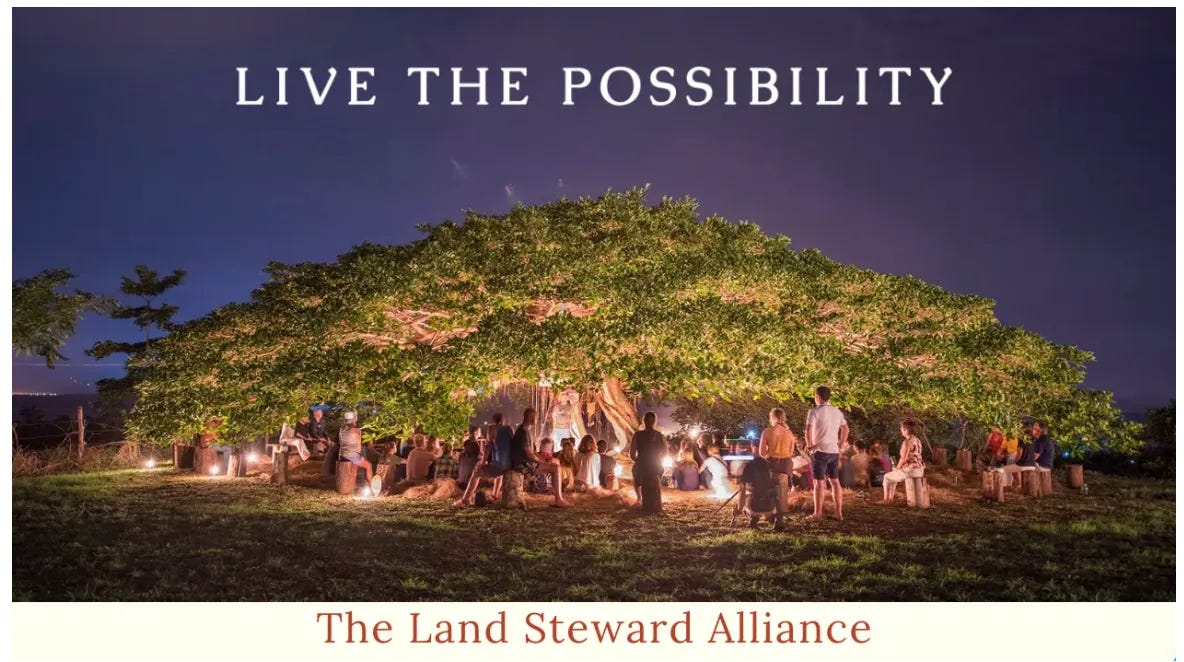054: Vision Alone Won’t Save You (But This Might)
Newsletter 054: Cooperation in Times of Change & Some Lessons from the Jungle
Hey friends,
What happens when your vision seems clear, but the path forward isn't? In this edition, we explore why so many well-intentioned land projects lose their way — and what it really takes to try and bring regenerative communities to life. I share takeaways from an honest and provocative conversation with Zach Anderson, Head of Community at La Ecovilla San Mateo, as we unpack lessons on aligned leadership, adaptive governance, and co-evolving with people and place.
Also please check out our new Giving Section at the end of the newsletter!
Over the years, I’ve sat with dozens of dreamers: founders with big hearts, architects sketching utopias, visionaries describing villages built on love, nature, and shared purpose. And yet, I’ve also watched some of those same visions bend — or break — under the weight of implementation. One of the most common disconnects I witness—especially in early-stage land projects and mission-driven ventures—is between vision and execution. It’s a critical gap, that has to be bridged, with the right support.
The vision is often big, bold, and beautiful. A new way of living. A regenerative village. A healing center. But as the pieces begin to fall into place—funding, land, team—I notice something: the strategy doesn’t always honor the original vision.
This is where the real work begins. Because vision without a sounds strategy is just a dream. And strategy without proper execution will leave you spinning your wheels.
From Idealism to Mutualism
What I’m coming to understand through my experience with land projects, and more recently, through the lens of regenerative development — is that many visionary projects fail to hit the mark because they project an ideal onto place, rather than being in relationship with it and listen to what that place calls for. Study what that place calls for, ecologically, socially, economically… Well intentioned humans, often plop their vision on a beautiful property and assume its whats needed in that place, before listing to it. To the land, to the people, to al of “it.”
In the Regenerative Practitioner Training, I just took with Bill Reed and the Regenesis Institute, we talked about moving from control to co-evolving mutualism — designing with the awareness that you are part of the system you’re trying to shape.
This means slowing down, listening more, and living into the questions instead of rushing to answer them. It’s more ask than tell, and something I’m working on in my own life with daily practice and accountability, thanks to my friends at Leap Forward.
Questions like:
What is this place asking for? What ecological systems am I a part of here?
How can I serve the whole, not just my needs? What does the local community need most? Where can I be useful and apply my gifts and skills?
Am I co-creating with others, or operating from transaction and control?
This is the practice. This is the path. It’s a discovery more than an imposition of will.
It’s a responsibility to hold that involves a sensitive relationship between people and place, and people and people :) And I find it important to be aware of this at the onset.
Lessons from the Jungle (and the Real Work of Building Community)
Which brings me to the conversation I had this week with Zach Anderson, from La Ecovilla San Mateo, a regenerative neighborhood in Costa Rica’s Machuca Valley. Zach joined us for our Land Steward Alliance Monthly Workshop, and what he shared brought these concepts into focus — not as theory, but as his lived experience.
Here’s what stood out:
🖐 Decision-making matters
They’re using models for decision making like the “Fist of Five” model, where each hand signal carries weight — from a full stop (fist) to an enthusiastic yes (five fingers). It fosters trust-based governance, not just efficiency. As long as no one is a hard no, the consent based system allows decision to move forward.
🌱 Diversity needs design
You won’t get perfect alignment between developers, locals, and new residents. But rather than forcing agreement, Zach suggests designing for diversity — creating systems where varied perspectives can coexist and contribute.
🤝 Integration over isolation
On gentrification, Zach’s approach is rooted in respect: build with the local community, not over them. Listen. Be in relationship. Let the project be a gift to everyone it touches.
🌀 Adaptability is the way
There’s no perfect model. What matters is a culture of dialogue, humility, and willingness to evolve with your people and place.
These aren’t just soft skills. They’re part of the architecture of creating community.
What this dialogue with Zach makes one realize is that: even the best-designed structures collapse if the people within them aren’t evolving. If they aren’t in the awareness that they are part of a co-evolutionary environment, and it’s up to them to choose if they want to play and participate or not.
Leadership in a Living System
It’s easy to think leadership means having the answers. But what if leadership today is more about cultivating capacity — to stay present, adapt, and work together across difference?
Zach’s example in the Interview show us that effective leaders are those who can:
Stay grounded amidst uncertainty
Facilitate cooperation over coercion
Design for emergence, not just execution
This is what it means to lead in a living system.
You don’t impose change — you participate in evolution.
These are the Conversations we are having at the LSA
Inside the Land Steward Alliance, we’re diving into these deeper questions through workshops, mentorship, and shared practice among a group of peers with a common vision and values for conscious land stewardship and a thriving planet.
We explore how to build resilient people, living frameworks, and place-sourced projects that actually stand the test of time — because they’re rooted in relationship.
If you missed the Zach Anderson workshop, I highly recommend you taking some time to give it a watch. It’s packed with wisdom for anyone walking this path:
🎥 Watch the Full Workshop Here
🌱 Giving Section
This is a new section for causes that really move me and that I support financially. I truly believe in the power of transformative philanthropy at any scale, to ease suffering and improve the lives of others. If you haven’t given in a while, give it a go, and feel the love.
Futuro Nativo: Supporting the Indigenous Tribes of Costa Rica
It’s been an amazing journey working with Futuro Nativo, and founder Philippa Attwood, to support the indigenous tribes of Costa Rica. We’ve had the opportunity through our Land Steward Alliance and Live the Possibility, to make meaningful impact on a number of indigenous communities who urgently needed support.
Healing Israel Together: Supporting Severe Trauma Victims of All Race & Religion
In response to the massive surge in PTSD, anxiety, and depression following the Oct 7th attacks in Israel, the David Center—launched with Leap Forward—is delivering innovative and specialized trauma therapy where it's needed most. Partnering with the Y.N.R Center and METIVTA, they've created a patient-centered, accessible, and culturally sensitive model. This is a two-year project that will aim to train 100 therapists and treat at least 600 individuals who have experienced trauma.
⚡️ Land Project Compass Assessment ⚡️
I've created a powerful tool to help you assess where you're at with your land project called - The Land Project Compass Assessment. It's free, takes 5 minutes, and it will reveal a lot! Regardless of whether you have a project already underway, or are actively dreaming something up, this assessment will help guide you to the heart of what's important. After completing it, you'll get a visual scorecard of your project's health, important insights across key areas, and suggestions for next steps if you are looking for support. I hope this assessment helps you see yourself and your reality with greater clarity. Click here to take the assessment now.













